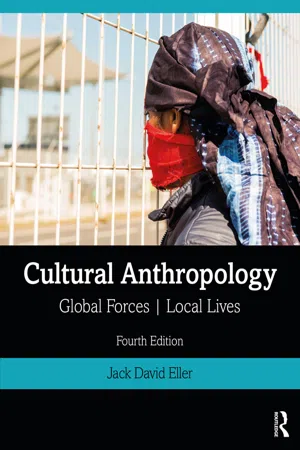
- 394 pages
- English
- ePUB (mobile friendly)
- Available on iOS & Android
About this book
Cultural Anthropology: Global Forces, Local Lives is an exceptionally clear and readable introduction that helps students understand the application of anthropological concepts to the contemporary world and everyday life. It provides thorough treatment of key subjects such as colonialism and post-colonialism, ethnicity, the environment, cultural change, economic development, and globalization.
This fourth edition has a fresh thematic focus on the future, with material relating to planning, decision-making, design and invention, hope, and waiting. More space is devoted to contemporary topics, and there is new coverage of subjects ranging from white nationalism, right-wing populism, and natural disasters to surgical training, hacker conferences, and the gig economy. Each chapter contains a rich variety of case studies that have been updated throughout.
The book includes a number of features to support student learning, including:
- A wealth of color images
- Definitions of key terms and further reading suggestions in the margins
- Questions for discussion/review and boxed summaries at the end of every chapter
- An extensive glossary, bibliography, and index.
Additional resources are provided via a comprehensive companion website.
Frequently asked questions
- Essential is ideal for learners and professionals who enjoy exploring a wide range of subjects. Access the Essential Library with 800,000+ trusted titles and best-sellers across business, personal growth, and the humanities. Includes unlimited reading time and Standard Read Aloud voice.
- Complete: Perfect for advanced learners and researchers needing full, unrestricted access. Unlock 1.4M+ books across hundreds of subjects, including academic and specialized titles. The Complete Plan also includes advanced features like Premium Read Aloud and Research Assistant.
Please note we cannot support devices running on iOS 13 and Android 7 or earlier. Learn more about using the app.
Information
1
Understanding anthropology




THE SCIENCE(S) OF ANTHROPOLOGY
- How many different ways are there to be human? That is, what is the range of human diversity?
- What are the commonalities across these different kinds of humans and human lifeways?
- Why are humans so diverse? What is the source or explanation of human diversity?
- How do the various elements of a particular human lifeway fit together?
- How do human groups and their lifeways interact with each other and change over time?
Physical or biological anthropology
Table of contents
- Cover
- Half Title
- Title Page
- Copyright Page
- Contents
- Detailed chapter outline
- List of illustrations
- Introduction
- CHAPTER 1 UNDERSTANDING ANTHROPOLOGY
- CHAPTER 2 UNDERSTANDING AND STUDYING CULTURE
- CHAPTER 3 THE ORIGINS OF CULTURAL ANTHROPOLOGY
- CHAPTER 4 LANGUAGE AND SOCIAL RELATIONS
- CHAPTER 5 CULTURAL CONSTRUCTION OF PERSONS: PERSONALITY AND GENDER
- CHAPTER 6 INDIVIDUALS AND IDENTITIES: RACE AND ETHNICITY
- CHAPTER 7 HEALTH, ILLNESS, BODY, AND CULTURE
- CHAPTER 8 ECONOMICS: HUMANS, NATURE, AND SOCIETY
- CHAPTER 9 KINSHIP AND NON-KIN GROUPS: BEING, BECOMING, AND SOCIAL ORGANIZATION
- CHAPTER 10 POLITICS: SOCIAL ORDER AND SOCIAL CONTROL
- CHAPTER 11 RELIGION: RELATING TO THE NON-HUMAN WORLD
- CHAPTER 12 CULTURAL DYNAMICS: TRADITION AND CHANGE
- CHAPTER 13 COLONIALISM AND THE ORIGIN OF GLOBALIZATION
- CHAPTER 14 THE STRUGGLE FOR POLITICAL IDENTITY IN A MOBILE AND UNCERTAIN WORLD
- CHAPTER 15 ECONOMICS IN A GLOBALIZED WORLD: DEVELOPMENT, MODERNIZATION, AND NEOLIBERALISM
- CHAPTER 16 CULTURAL SURVIVAL AND REVIVAL IN THE TWENTY-FIRST CENTURY
- Glossary
- Bibliography
- Index